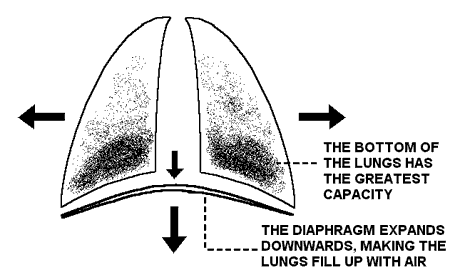-
Inhaling large amounts of air - important for long phrases.
-
Being able to fill the lungs quickly - to snatch a breath between lines of a song.
-
The most important for singing: Controlling the escape of breath.
Sit down and relax. Now think about your breathing. How much is your ribcage moving? How about your lungs - are they moving much? Can you feel your diaphragm - that is the muscle structure which supports the bottom of the lungs: is it moving?
Your breathing is shallow when the body is at rest, as the body does not require large amounts of oxygen.
Well, when you are singing your breathing is going to be very different.
First of all, try this: take a really big breath in. Fill your lungs up and hold your breath. Now, can you feel what has happened to your lungs, shoulders and ribcage?
If your shoulders are hunched up and your upper ribcage seems to have expanded, as is usual when most people try this exercise, be aware that this is totally the wrong way to take a big breath when singing!
You need to breathe in from the diaphragm...if you place your hand on your stomach muscles you should feel them moving OUTWARDS as you breathe inwards. This is because as the diaphragm pulls outwards and downwards, it physically draws air into the lungs and expands their shape. The lungs are pear shaped. Think of the bottom of the pear getting bigger as the diaphragm pulls outwards.

Okay, now we are going to do some exercises which should get you better aquainted with your diaphragm...ready?
Exercise 1. “The Flatback”
The purpose of this exercise is to enable you to feel exactly what your diaphragm is doing when we breathe.
Lie on your back.
Breathe in through your nose...take in lots of air. As you do so, make you diaphragm rise: fill up from the bottom of the lungs.
Then breathe out through your mouth, as if you are blowing up a balloon. You will need to use your diaphragm to push the air out of your lungs. Notice that you seem to be able to breathe out for a lot longer than you breathe in! Try to keep the flow of air smooth as you exhale.
Now, place your hand on your tummy, as you breathe in, you should feel your hand rise. Use your diaphragm to push the air out again.
Repeat...repeat...repeat...this is how your diaphragm needs to work for you to sing properly.
Exercise 2. “The Spring Clean”
The idea of this exercise is to get rid of all the stale air in the bottom of the lungs and replace it with fresh air.
Take in a deep breath. Now, using your diaphragm, starting with the base of the lungs, start squeezing all that old air out. Keep going, steadily pushing inwards and upwards with the diaphragm. It will start to feel empty, but keep going until the lung capacity is completely exhausted. You’ll need to squeeze! Don’t let the ribcage collapse, but try to hold it in position - let the diaphragm do the work.
Now inhale through the nostrils, which will warm the air up before it reaches the lungs. Fill up. Stretch as you do so. Breathe in through your nostrils and out through your mouth a few more times. Feel better? Try this exercise before you sing, you will feel your lung capacity has been stretched, and you may feel more alert as a result of all that fresh oxygen in the lungs!
Exercise 3. “Panting”
This exercise is about learning the difference between ‘upper breathing’ and ‘lower breathing’.
Ready to make a fool of yourself?
Imagine you have just run a 100 metre race...how exactly would you pant?
Now pant like it...your upper chest rises and falls very quickly, and your ribcage moves quite a lot. This is not a good way to breathe when you are singing, as the upper part of the lungs doesn’t have a very large capacity, and the physical movement of the ribcage itself requires a lot of effort.
Now imagine you are a dog on a hot day. Try panting like a dog. Stick your tongue out. Rather than moving your ribcage, move your diaphragm backwards and forwards quite quickly: your lungs fill up with air almost automatically, the breath seems to come from a much lower part of the body. Now slow it down...feel the diaphragm moving and filling those lungs up? That’s just how we want the diaphragm to be working when we sing.
Okay. You can put your tongue away now.
© Tina & Ben Henderson 2007
Vocal performance tutorial index
Tutorial 1 - Breathing
Tutorial 7 - Volume production
